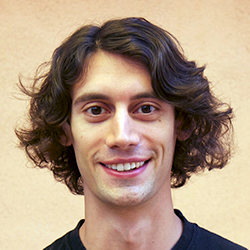Getting to Know Professor Daniel Lecoanet
Lecoanet joined ESAM in September
Daniel Lecoanet began his role as assistant professor of engineering sciences and applied mathematics in September. Still located in New York City and teaching remotely, Lecoanet enjoyed a stellar career before joining Northwestern Engineering.
We asked Lecoanet about his research, how his past experiences have shaped him as a teacher and researcher, and goals for his time at the McCormick School of Engineering.
 What are your research interests?
What are your research interests?
I mostly study astrophysical and geophysics fluid dynamics. That means I’m trying to understand the flow of plasmas in the sun and other stars, the flow of liquid metal in the Earth’s outer core, and the flow of air in the Earth’s atmosphere and water in the oceans. Some big scientific questions include: What causes the sun’s magnetic field to regularly reverse every 11 years? How is the Earth’s magnetic field generated? How will atmospheric and oceanic circulations change as humans release more CO2 into the atmosphere? Although these questions may seem very different, they rely on some similar underlying fluid dynamics. More specifically, I develop and run simulation codes that can help address these issues.
You’ve been at Princeton, the University of Wisconsin-Madison, the University of California, Berkeley, and also Cambridge University. How has living, working and studying in different places shaped you?
The most important thing is learning that people tackle problems in different ways all over the world. That’s true for scientific problems, as well as societal problems. It is easy to focus on what is commonplace wherever you are, without thinking about the different approaches taken elsewhere.
What attracted you to the ESAM program at Northwestern?
I was very interested in ESAM and Northwestern more broadly for several reasons. I think of myself as an applied mathematician, but there are not many applied math departments in the US, and often they are more on the math side than the applied side. In contrast, ESAM is very applied; everyone is working on specific science questions but tackling them from a more rigorous or mathematical perspective than others in the field. The applied nature of the department was very appealing to me. Furthermore, the wide breadth of what is being done is also very exciting: ranging from biophysics to fluid dynamics to neuroscience. In addition, I am also a member of the Center for Interdisciplinary Exploration and Research in Astrophysics (CIERA), which promotes research and education in astrophysics. It’s a great center here on campus.
Academically, how would you describe your experience so far at Northwestern?
It has certainly been strange given the global health situation we find ourselves in! I’m still living in New York City and never thought I would start a new position without moving. That said, I’ve felt very welcomed into the department. It has also been great to interact with the graduate students and also undergraduates, which I have not done for several years.
What are your goals for your time at Northwestern?
My main goal is to build up a group of students and postdocs to try to tackle some big outstanding questions in astrophysical and geophysical fluid dynamics. The Dedalus code, which I help develop, has recently been extended so we can run simulations of a whole star, or the entire Earth’s outer core — these new capabilities have opened up a lot of exciting possibilities.
